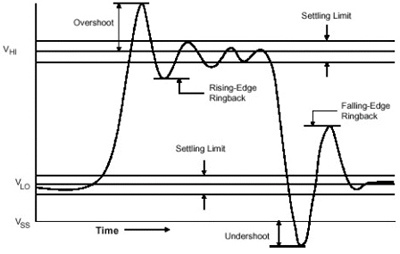Onder hetzelfde motto als de vorige post: beter laat dan nooit ![]() . GamePC heeft een tijdje geleden een interessant artikel geschreven over overklokken, hieronder een blurp uit een stukje waar ze uitleggen waarom je CPU soms vreemd gaat doen op een te hoge snelheid:
. GamePC heeft een tijdje geleden een interessant artikel geschreven over overklokken, hieronder een blurp uit een stukje waar ze uitleggen waarom je CPU soms vreemd gaat doen op een te hoge snelheid:
Below is a typical high-speed digital clock. You can clearly see the edges of the clock. Overshoot and undershoot are artifacts caused by the fact that while this is a digital process it is taking place in an analog world, and at high speeds it is difficult to make a transistor stable quickly (thus the need for setup and hold times). The real danger here is the ringback. Ringback can cause false data triggers and errors. If one of these errors occurred in a critical part of the CPU, then a lock-up occurs. Typically as speed increases, overshoot and undershoot increase, along with ringback. When ringback starts to interrupt the functions of the CPU, you get instability.

Another problem occurs as clock speeds increase. As we see below, a "shelf" starts to form on the waveform due to capacitance and impedance mismatches. These effects are also enhanced as the silicon heats up. So, good cooling (ie fan and air flow) are very important. You can see the areas marked V6 and V7 on the figure below show where the voltage stutters in transition. Again, double clocking of data can occur at this point (obviously, setup and hold times have been violated as well), if the stutter is large enough.
